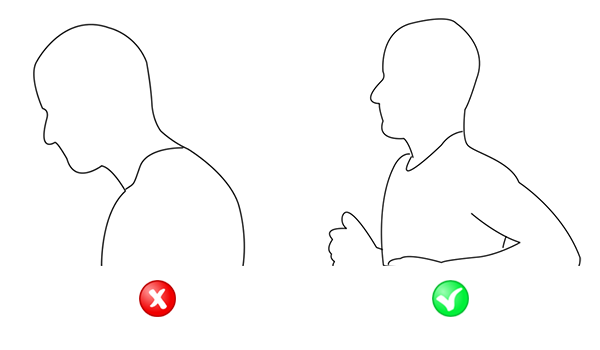I’ll start by stating the fact that there is no one best running form. If there was one – every single elite would be running the same way.
Runners come in different sizes and proportions. Each runner is different and they develop their own running mechanism.
That said, there are several mistakes many runners (including beginners and regular runners) make when it comes to proper running form. The purpose of this post is to point those out and help you learn how to implement these techniques to become a better runner.
The good news is these techniques are not hard to learn!
Let’s begin:
Forward Lean

When you walk, your body is pretty much straight and your foot lands on heel – ahead of your body. This posture is not efficient while running.
If you run with a walking posture:
- You will waste a lot of energy.
- The shock of landing while running is much more than walking. So the landing shock is not absorbed properly and your chances of getting injured increase tremendously.
To fix this…
…Lean forward.
Lean forward slightly from your ankles keeping your body in a straight line from head to toe. Do not hunch over or bend at the lower back. Your weight will shift to your toes and you’ll feel like falling forward. This is the posture you should keep throughout your run.
When you do this:
- Gravity works in your favor and you use less energy in moving forward.
- A proper lean also helps you land below your center of mass, decreasing the risk of injuries.
Note that, when you run at faster paces, you lean a little more. You can compare sprinters with long distance runners to see the lean in action.
Head Position

Look straight ahead about 20-30 feet ahead of you. Don’t look down. And keep your neck relaxed.
Many runners make a lot of movement with their head while running. it’s not optimal and makes them less efficient.
Related: The Myrtl Routine for Hip Strengthening [Infographic]
Shoulders
Do not hunch over or pull back your shoulders too much. Keep your chest out (slightly). You should feel relaxed and not feel the stress or tightness.
I used to have this problem, my shoulders would become tense and it felt uncomfortable while running. If you feel the same, shake up your arms a little and loosen your shoulders to make them relaxed.
Arms Position and Movement

For most people, keeping a 90 degrees angle at elbows works the best. But you’ll see some runners carrying their arms higher up to the chest while some lower.
I’d recommend, starting with your arms bent at the elbows at 90 degrees angle. And then experiment to see where you feel most relaxed with them. Try not to increase this angle too much either way.
Also, your arms should swing backward and forward not side to side. It means that your hand should not cross the middle of your torso. This is quite important because a side to side movement means your upper body is twisting way too much. This is not good for your spine. And it will make you a less efficient runner.
The movement of your arms should be natural and in rhythm.
Another important thing to remember is – not to clench your fists. When you do so, it causes tension that spreads to the rest of your body – making you use more energy than necessary. You can imagine that you are holding something fragile (like eggshells or potato chips) in your hands and you don’t want to crush it.
Related: Follow These Principles of Training to Become a Successful Runner
Foot Landing

It’s very important where your foot lands on the ground while running.
Your foot should always land right below your knee. If you land ahead of your knee it means you are overstriding. And overstriding can cause many running-related injuries. So avoid it at all costs.
In the recent past, there has been much debate on how your foot strikes the ground. Generally, runners can be divided into three categories based on foot-strike – Heel-strikers, mid-foot strikers, and forefoot strikers.
Many people are natural heel strikers. Their heel is the first thing that comes into contact with the ground but the weight of the body is evenly distributed throughout the foot. This is totally fine. The real problem is when the heels absorb most of the landing shock – which is the case with someone overstriding.
So remember, when it comes to foot strike, what’s important is, where your foot strikes the ground not how.
You can aim for a flat foot landing which means neither on your heel nor on your toes. A proper forward lean and landing below your knee will usually take care of this.
Also, try to land softly on the ground. The less sound your feet make while running, the better it is.
Cadence
Cadence is simply the number of steps you take per minute. Improving your running cadence has many benefits. It can help you improve your overall running mechanism.
Try to increase your cadence up around 180 steps per minute. Note that your cadence will decrease when you run slow and increase when you run at faster paces. Use cadence as a guide and increase until it feels natural.
Tip: There are several ways to look at your running technique. You can have someone (a coach or an experienced runner) to analyze your form. Or, you can record a video (my favorite way) of you running and then analyze it in slow motion to see if there is something you need to work on.
One Thing at a time
You might get overwhelmed as there is so much to a good running form. When you go out for running don’t try to focus on everything at the same time. Instead, focus on one aspect of proper running form at a time. For example, you can think about if you are standing tall and not slouching for a few moments. After some time, try to see if your shoulders are relaxed. And so on.
Constantly monitor your running form until good running techniques become your habit. And be patient, the changes will not happen overnight.
You can also perform running drills 2-3 times a week to improve your running form and speed.
To Summarize:
- Lean slightly forward keeping your body in a straight line from head to toe.
- Keep your head straight and look ahead, not down.
- Keep your chest slightly out and shoulders relaxed.
- Your arms should move backward and forward not side to side.
- Land your foot below your knee not ahead of it.
- Increasing your cadence can be a big help in correcting some running form inefficiencies. Try to increase your cadence close to 180 steps/minute.
- Finally, focus on one cue at a time.
You may also like:

GOOD MORNING,Healthy body is good for everything everywhere .Sir my weight is 150 kg and with GOD gift I daily swim for 1 hour in swimming pool.So please guide me to reduse my weight.
Hi Jitesh,
It’s great to hear that you can swim for an hour!
Now, when it comes to losing weight, there is a ton of information available online and offline. And it is often complicated by people who want to make money from you. There are so many programs to purchase, expensive gym memberships and what not.
But in reality, losing weight is quite simple. It all comes down to calories. If you consume more calories than you burn, you’ll gain weight. And if you burn more calories than you consume, you lose weight. It’s really that simple.
Here are the steps you can take in order to lose weight:
Finally, remember that it takes time to change your body, so be patient. Most people want to see the results quickly and when they don’t see it, they get discouraged.
Feel free to ask if you have any further questions. All the best to you!
Great post, very informative..✌️
I’m glad you liked it.